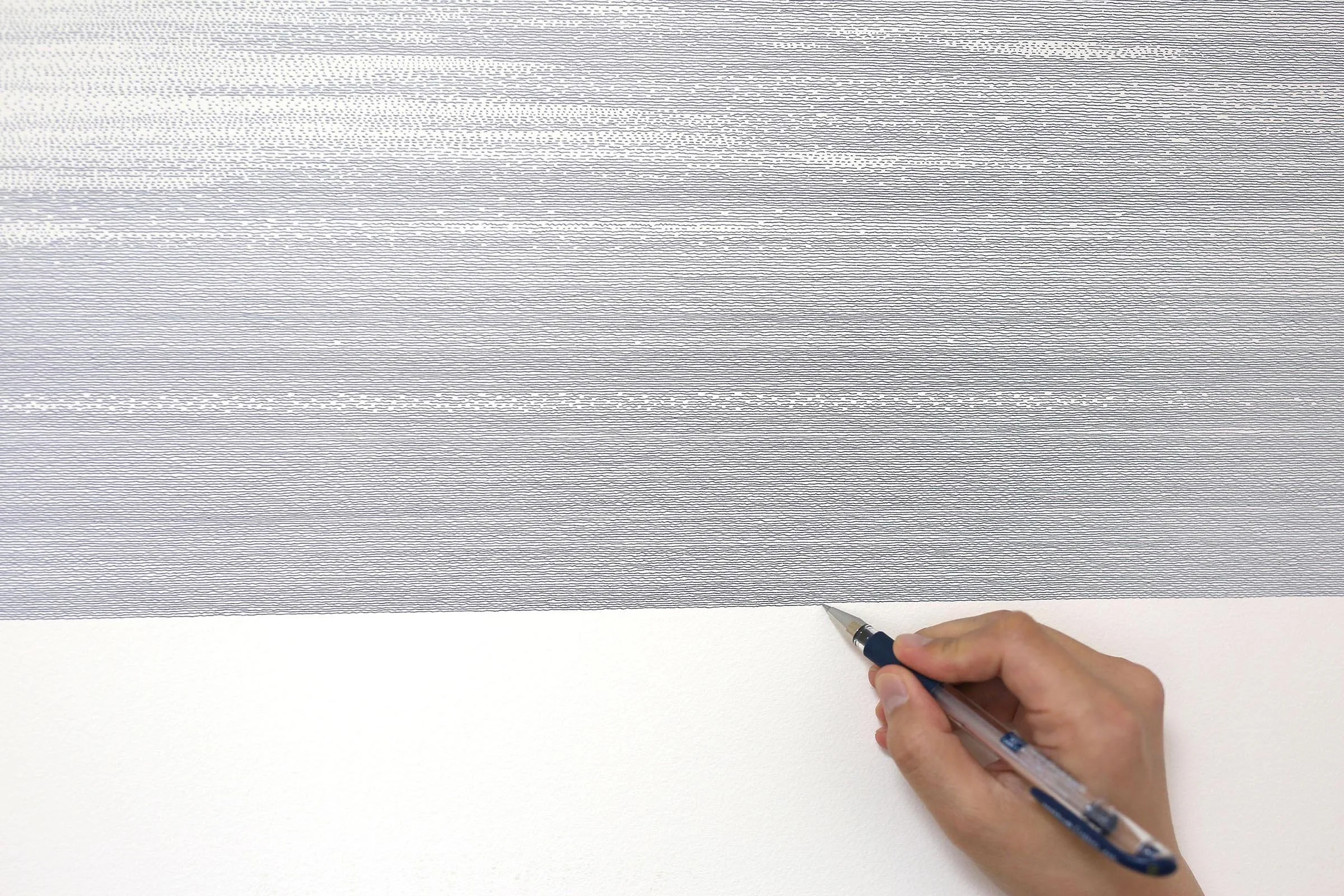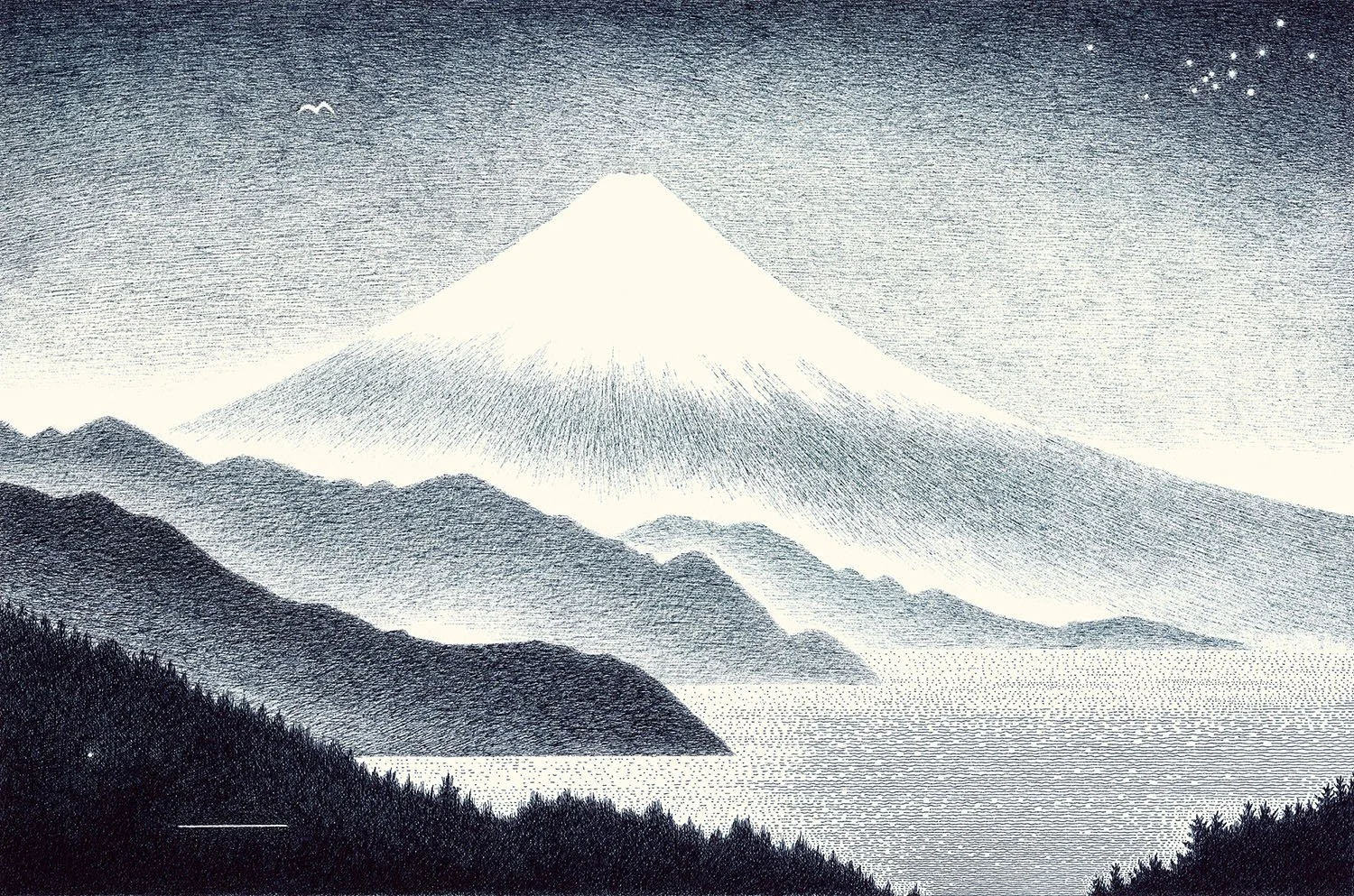Why we spoke with Shunshun
At Form Interiors, we deeply value original artworks—not only for their visual impact, but for the feeling they bring to a space. To live with a piece that’s been shaped by an artist’s hand is to experience their time, their thoughts, and their quiet dedication. It’s a form of luxury that’s deeply human and profoundly personal.
This is why we seek out artists whose work stirs something within us. Artists like Shunshun, whose practice is rooted in patience, presence, and an almost meditative awareness of light and space. His drawings—made entirely with a ballpoint pen—offer a quiet kind of beauty, one that invites you to slow down, look closer, and feel more.
We were honoured to speak with Shunshun about his journey, creative process, and how he brings subtlety and depth into every line he draws.
In this interview, Shunshun shares insights into his creative process, the philosophies that shape his work, and the inspirations he finds in the landscapes he visits.
His art is an invitation to slow down and observe the quiet beauty that exists in the spaces between light and dark. Using nothing but a ballpoint pen he created delicate, intricate lines that seem to breathe on paper. Offering a glimpse into the mind of an artist who sees beyond what meets the eye.
What inspired you to become an artist and how did you develop your unique style?
While studying architecture at university, I developed a habit for traveling to see buildings and capture them through photography. One trip took me to Switzerland, to see the works of Peter Zumthor - a journey I had looked forward to immensely led to an unfortunate twist, I lost my beloved camera. At the time, it felt like a disaster; I had no way to document my trip, so I turned to the only option left: sketching.
At first, it was just a way to document what I saw, but as I continued, I found myself completely absorbed in the process. Line after line, the buildings came to life on paper, and what started as a necessity quickly became a deep source of joy.
That moment marked the beginning of my passion for creating line drawings with a ballpoint pen.
Soon, I became fascinated by something deeper: the idea of drawing lines unconsciously. Yet, the more I tried to be unconscious, the more aware I became of the act itself. To move past this paradox, I abandoned the ruler and let my hand guide itself, drawing line after line in repetition.
As I continued, something shifted within me. A sense of stillness, a feeling of zen emerged. It felt like I approached a state of nothingness. On the blank paper before me, light and waves seemed to form outside of my awareness. I began to understand that my process of drawing lines over and over is not just an artistic practice, but is also prayer, breath, and meditation.
Are there any artists or art movements that influenced your work?
When asked about the artists and movements that have influenced his work, Shunshun’s response reveals a diverse range of inspirations, painting, architecture, poetry, and the list goes on. His influences reflect his deep appreciation for both Western and Japanese art traditions from the compositions for Nihonga to the modern architects. These creative figures and movements have shaped his perspective, each contributing to the quiet yet profound depth found in his work.
Modern artists: Claude Monet, Paul Klee, Giorgio Morandi
Contemporary art: Gerhard Richter, Rei Naito, Hiroshi Sugimoto
Ukiyo-e (woodblock art): Hokusai, Hiroshige
Nihonga painting: Kaii Higashiyama
Illustrator: mitsumasa Anno
Architect: Le Corbusier, Peter Zumthor, Yoshio Taniguchi
Art critic /Antique Creator: Kazumi Sakata
Poet: shuntaro Tanikawa
What challenges do you face as an artist and how do you overcome them?
I try not to be bound by rigid plans, instead allowing intuition to guide me. I’ve come to believe that the right people and places play an essential role in my creative process. When I find myself in the right setting, it feels as though my work can transcend its usual limits, reaching a deeper, more refined level of expression. These meaningful interactions aren’t something I can force - they happen naturally. And when they do, they open the door to new creative possibilities.
Could you tell us about a memorable project or piece you’ve worked on?
It was at the Museum of Art Ehime for the Watashi no Umi ART/LIFE (February 7 - March 24, 2024). It was in the epilogue section , Now / The Future of the Seto Island Sea, I created an immersive space featuring three works: Hyakkanjima (120-size canvas), Kirosan (A2-size), and a video piece. Seeing visitors and museum staff moved by my installation artwork was a deeply rewarding experience. Their reactions were a reminder that art isn’t just something to be observed but it has the power to create profound emotional connections—That experience and realization has stayed with me to this day.
「描かなかったところが光となる
自分が引いた線はすべて影だったのかもしれない」
—Shunshun
Is there a particular emotion or message you hope to convey through your artwork?
“Drops of lights appear where I haven’t touched
Shadows are perhaps all we could portray” —SHunshun
When I sit before a blank sheet of paper, I don’t see emptiness. In my mind, the page is already filled with light - it just needs to be molded and shaped to be perceived. By drawing the lines as shadows, I reveal the light that was already there. In a way, this is the essence of my work: expressing the idea that light exists within you.
The intricate dots and lines I create connect to something even deeper. They remind me of quantum mechanics - elementary particles and waves, constantly shifting, forming, dissolving. My ballpoint pen strokes are delicate, fleeting, yet at times, they seem to breathe. There are moments where I even feel as if the artwork itself is alive.
How does Japanese culture influence your art? Are there any specific elements or themes you like to incorporate?
I only create my pieces using a blue-black ink. There’s something about this color that calms my mind, drawing me into a deep connection with the sea, the sky, and the vastness of the universe. I believe it resonates with the wavelength of Japan Blue, the indigo dye that has been cherished in Japan for centuries.
And of course, there are influences from Japan’s landscapes and traditions that find their way into my work - maple leaves, pine needles, plum blossoms. The lattice windows of Kyoto townhomes. The quiet elegance of nature, architecture, and traditional craftsmanship. These details are not always intentional, but they emerge, like echoes of something deeply ingrained in me.
Can you describe your creative process and How do you start a new piece?
I seek inspiration by immersing myself in mother nature, letting her guide my senses. When I return to the studio, I work from sketches, photographs, and more importantly - the energy I absorbed through my eyes, body, and spirit. The experience lingers, shaping each piece in ways that go beyond what I can physically capture.
Some ideas arrive unexpectedly, often in the quiet of early mornings after waking from a deep sleep. It’s as if my mind has been working in the background, assembling new images while I rest.
Gallery exhibitions bring another layer of discovery. The atmosphere of the space, the way the light moves, the conversations I have with curators - all of these elements spark new themes and directions. I create with an awareness of how art interacts with its surroundings, mindful of the psychological effect it has within a space. A piece isn’t just something to be seen - it shifts the energy of the room, shaping the experience for those who enter.
To learn more about shunshun: follow him on Instagram @shunshunten










photo/art credits: all images featured in this blog are courtesy of shunshun and have been shared with permission











